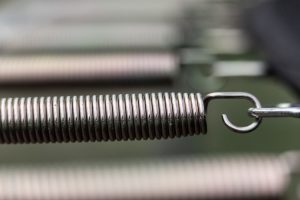 Knowing how to calculate a spring constant is essential in the design and manufacture of springs. Before a spring is produced for an application, engineers need to know how the spring will behave and function to determine whether the design is suitable for the application. Obviously, the spring designed for use in a car’s suspension does not require the same design for a Pogo stick. For each, engineers and designers use Hooke’s law of elasticity to calculate the spring constant and force necessary for the respective application to function as designed. It’s worth a closer look.
Knowing how to calculate a spring constant is essential in the design and manufacture of springs. Before a spring is produced for an application, engineers need to know how the spring will behave and function to determine whether the design is suitable for the application. Obviously, the spring designed for use in a car’s suspension does not require the same design for a Pogo stick. For each, engineers and designers use Hooke’s law of elasticity to calculate the spring constant and force necessary for the respective application to function as designed. It’s worth a closer look.
Anyone who has ever extended, compressed or twisted a spring knows instinctively what happens when it’s released. Whether a garage door, jack-in-the-box or mousetrap, the restoring force of the spring will ensure it returns to its original length. Unexpectedly or not, once it happens, when the stress applied to an elastic material is removed, the spring will return to a position of equilibrium. And it will do so equal to the force placed upon it.
This is, essentially, the basis of Hooke’s law of elasticity. Named for the 17th-century British physicist Robert Hooke, whose decades of research on elasticity and the deformation of objects culminated in the publication of his findings in 1678. Though varying types of springs had been in use for thousands of years, it was Hooke, through his observations, who first articulated in writing the linear relationship between the extension of a spring and its restoring force. He concluded, tersely, “as the extension, so the force.”
In Hooke’s law, when a force is placed on a material, the material stretches or compresses in response to the force. In the laws of elasticity, the deformation of a material is directly proportional to the deforming force or load. Once the stress is removed, the material returns to its dimension before the load or stress was applied. The deforming force is reversed and the material ‘springs back.’ It must be noted that, as Hooke’s law describes a material’s elastic properties only within the range in which spring force and displacement are proportional, there are exceptions to it. Every spring has an elastic limit and if it is reached—extended too far or compressed too much—it will remain permanently deformed and cease to conform to the law.
Springs are elastic mechanical objects which have their limits. After they are deformed—stretched, squeezed, bent, twisted or compressed—they have the mechanical properties to return to their original shape. Over the centuries springs have proved to be an indispensable application in the function of a wide assortment of mechanical devices and mechanisms. Today, the familiar elastic coil is an integral component found in engines, appliances, tools, vehicles, machinery, toys, medical instruments—even for the operation of a simple ball-point pen! The widespread application of springs is due to their ability to store mechanical energy. The force of a spring is reactive, which generates mechanical energy when released.
Spring Constant
How much energy is released proportionally, i.e., the constant of proportionality in Hooke’s law, is the spring constant. In Hooke’s formula, the spring constant is represented by the algebraic value, k. Mathematically, Hooke’s law is expressed as F = kx, where the applied force F equals a constant k times x, the length of deformation or change. The value of k depends not only on the kind of elastic material under consideration but also on its dimensions and shape, the wire diameter comprising the spring, the diameter of each coil, the free length of the spring at rest, and the number of active coils.
The importance of calculating the spring constant in any application is in determining exactly how much force will be required to deform a spring. The spring constant calculates the stiffness of a spring and the required load to stretch or compress it. Springs with larger spring constants will have smaller displacements than springs with lesser spring constants for the same mass added. In other words, a higher spring constant will result in a stiffer spring, and vice-versa.
In Hooke’s law, the spring constant (k) is a property of the spring itself, which shows the linear relationship between the force (F) and the displacement (x). The amount of mechanical energy stored and used by a spring is relative to the force and displacement—the harder a spring is pulled, the harder it pulls back.
For manufacturers, a spring’s design cannot be left to guesswork or approximation. Knowing how to calculate the spring constant is critical to ensure the right spring will be coiled, as intended, for the application. For technical guidance, our Sales Engineers are a valuable resource for helping you with product specifications and the manufacturing method that will assure the highest quality at the lowest cost. Contact us today!

